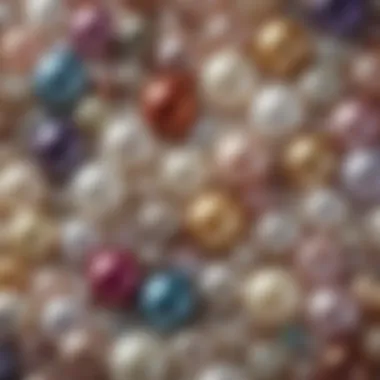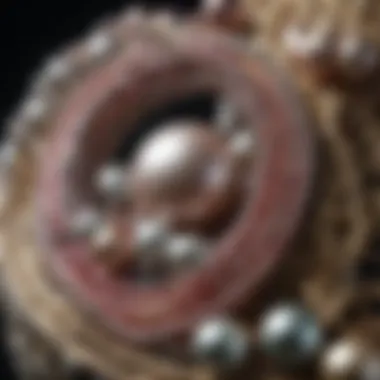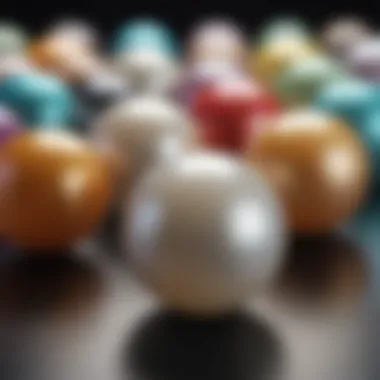Understanding Pearl Color Rarity: A Comprehensive Guide


Intro
In the realm of gemstones, pearls stand out due to their unique origins and aesthetic appeal. They are not merely gemstones; they are organic treasures formed within the soft tissue of mollusks. This article seeks to provide a thorough exploration of pearl color rarity, shedding light on how various hues impact their desirability and value.
When considering pearls, color plays a crucial role in determining rarity. From classic whites to vibrant blues, each color tells a story of the environment and conditions in which the pearl was formed. Not all colors are created equal in the world of pearls, and understanding this hierarchy of hues can greatly enhance both appreciation and investment potential.
We will navigate the intricate landscape of pearl colors, addressing the factors influencing their rarity, classifications, and market dynamics. Our aim is to equip enthusiasts, collectors, and potential buyers with the knowledge to make informed decisions in this captivating world.
Gemstone Overview
Definition and Origins
Pearls are an exception among gemstones as they originate from living organisms rather than geological processes. They form as a defense mechanism against irritants that invade a mollusk, such as a grain of sand or a parasite. The mollusk secretes layers of nacre, a combination of calcium carbonate and organic substances, which gradually builds up to create a pearl.
Historically, pearls have been prized across cultures. Ancient Egyptians viewed pearls as symbols of wealth and status. The Romans believed they brought divine protection. Today, they continue to symbolize elegance and beauty, making them a frequent choice in fine jewelry.
Historical Significance
The allure of pearls dates back to antiquity. In ancient China, the demand for pearls sparked trade routes. In Europe, the discovery of the Americas revealed new sources of pearls, influencing jewelry trends and wealth distribution.
Throughout history, pearls have adorned royals and celebrities. They have often been associated with significant events, such as weddings, where they symbolize purity and innocence. Their rich history is intertwined with the development of jewelry design, reflecting changing tastes and social norms.
Gemstone Properties
Hardness and Durability
Pearls are relatively soft compared to other gemstones. They measure between 2.5 and 4.5 on the Mohs scale. This means they require careful handling to avoid scratches and damage. Unlike diamonds or sapphires, pearls demand special attention in storage and maintenance, which can influence their longevity and condition.
Color and Clarity
The color of a pearl greatly affects its market value. Natural pearls exhibit colors influenced by the type of mollusk and their environment. Common colors include:
- White
- Cream
- Pink
- Blue
- Black
Each color has a unique significance in different cultures. For instance, black pearls are often viewed as exotic and rare, while white pearls remain classic and elegant.
Clarity also plays a significant role. A pearl should be free from blemishes and possess a smooth surface. The luster, or sheen, of the pearl further enhances its appeal. Pearls with high luster reflect light beautifully, increasing their desirability.
"The color of a pearl can enhance its allure, making it an essential consideration in its valuation."
Preamble to Pearl Color Rarity
The topic of pearl color rarity is significant in understanding both the aesthetic and economic aspects of pearls. It reflects not only the beauty of pearls but also their market value, which can greatly vary based on color characteristics. Pearl enthusiasts, collectors, and jewelry designers often prioritize color when assessing a pearl's worth. Knowing how color influences rarity helps buyers make informed decisions while navigating the often complex jewelry market.
Defining Pearl Color
Pearl color is a multifaceted attribute that encompasses various elements. These include the pearl's base color, overtone, and luster. Base color refers to the primary hue of the pearl. It can range from white to black and include shades like pink, gold, and blue. Overtone is a secondary hue that can appear to glow over the base color, giving the pearl depth and complexity. Luster describes how well light reflects off the surface of the pearl, influencing its visual appeal.
The classification of pearl color also involves understanding the origin of the pearl. Natural pearls, cultivated in oceans, have their colors formed organically, while cultured pearls are farmed with human intervention. This differentiation plays a crucial role in defining color rarity.


Why Color Matters in Pearls
The color of a pearl significantly contributes to its desirability and market value. Different colors evoke different emotional responses and cultural associations. For instance, white and pink pearls are often associated with purity and innocence, while black pearls may suggest elegance and mystery.
Furthermore, certain colors are inherently rarer than others. For example, the rare gold or blue pearls tend to fetch higher prices due to their limited availability. Pearls with unique overtones—like rose or silver—are also highly sought after. Understanding these nuances is critical for anyone interested in purchasing or curating pearls.
Pearls are more than just decorative items; they carry stories of origins and elegance tied to their colors. Knowing the significance of each hue enhances appreciation.
Classification of Pearl Colors
Understanding how pearls are classified by color is crucial for anyone interested in the world of pearls. Each shade not only represents a unique aesthetic value but also plays a significant role in the overall valuation of pearls. The classification helps enthusiasts and collectors identify varieties, appreciate their rarity, and makes informed decisions when buying or selling. The distinction between natural and cultured pearls, as well as recognizing common or rare colors, can greatly influence market dynamics and consumer preferences.
Natural vs. Cultured Pearls
The battle between natural and cultured pearls is a fundamental aspect of pearl classification. Natural pearls form without human intervention. They develop in the wild when a foreign object enters an oyster. The oyster secrets layers of nacre around the irritant, forming a pearl. As such, natural pearls are exceptionally rare, and their natural hues carry immense appeal.
On the other hand, cultured pearls are produced intentionally through human intervention. Farmers insert a bead or piece of tissue into an oyster to stimulate pearl formation. Cultured pearls can exhibit a broader range of colors because they are often dyed. However, they remain valuable in their own right, especially when produced by reputable farms.
In summary, knowing the difference between natural and cultured is foundational. Natural pearls are often preferred for their rarity. Conversely, cultured pearls offer variety and accessibility.
Common Color Variations
When discussing common color variations in pearls, one must consider several shades that frequently appear in the marketplace. These include classic white, cream, pink, and silver. These colors result primarily from the type of oyster. For instance, Akoya pearls typically come in shades of white and cream, while Tahitian pearls are known for their darker hues, often ranging from gray to black with green or purple overtones.
Also, the presence of additional tones adds depth to the pearl's appearance. Common pink pearls can show hints of lavender or peach undertones. While these colors are more prevalent, they still hold a unique charm and are widely appreciated. They are more accessible for jewelry enthusiasts and often serve as an entry point into the world of pearl collecting.
Unique and Rare Colors
Unique and rare colors stand out within the realm of pearls. Some shades are so uncommon that they can significantly raise the value of the pearl. For instance, golden pearls originating from the Pinctada maxima oyster are highly sought after. Another rare color includes deep blue, which is exceptionally scarce. Such colors often come with intriguing backstories about their origin or specific farming methods.
A notable example is the exceptional lavender pearl, which can be so nuanced that they become conversations starters. Color rarity not only appeals visually but also adds a layer of significance. Pearls in rare colors are often seen as a status symbol in affluent circles, fetching higher prices.
Pearl Color Rarity Chart
The Pearl Color Rarity Chart is essential for understanding the complexity of pearl value and desirability. This chart categorizes pearls based on their color characteristics and rarity levels, providing a clear visual guide for enthusiasts, collectors, and buyers. It distills a wide variety of colors into manageable classifications, making the purchasing decision easier.
By analyzing the chart, readers can quickly assess the color spectrum and recognize what makes certain shades more sought after than others. This aspect is critical for anyone in the jewelry market, as the chart highlights not only the aesthetic appeal but also the investment potential of specific pearl colors.
Overview of Rarity Levels
The Rarity Levels can be divided into distinct categories: common, uncommon, rare, and extremely rare colors. Each category serves as a basis for understanding the market dynamics that influence pearl valuation.
Color Rarity Index
Common Colors
Common colors such as white, cream, and light pink dominate the market. These hues make up the majority of pearls found globally, and they hold broad appeal due to their versatility. The key characteristic of common colors is their abundance; they are widely available, leading to lower prices.
However, the unique feature of common colors is their ability to blend effortlessly with various settings and styles. This advantage makes them a popular choice among consumers who prioritize versatility over uniqueness. On the downside, their lower rarity means they may not provide the same investment value as more unique shades.
Uncommon Colors


Uncommon colors like lavender and golden hues present an intriguing alternative to mainstream choices. Their relative scarcity compared to common colors contributes to a higher perceived value. The key characteristic of uncommon colors is their capacity to stand out while retaining elegance and charm.
These colors can attract serious collectors and enthusiasts looking for something distinctive. However, being less common can make them occasionally harder to find, which might pose a challenge for those who want them for specific designs or collections.
Rare Colors
Rare colors, such as blue and dark green, are sought after for their striking appearances. The key characteristic of rare colors is their limited availability, which significantly increases their desirability and price. Collectors often seek these hues for their captivating nature.
The unique feature of rare colors is their ability to serve as remarkable conversation pieces in jewelry. They tend to command higher prices, making them beneficial for investment purposes. However, their rare status can mean difficulty in sourcing the right shade, leading to potential inconvenience for buyers.
Extremely Rare Colors
Extremely rare colors, such as deep black and certain shades of gold, are exceptionally coveted in the pearl market. The key characteristic of extremely rare colors is their striking individuality, which elevates their status among collectors and designers.
These pearls often come with high price tags due to their uniqueness and limited availability, establishing them as premium investments. Their unique feature lies in their ability to make a bold statement in any jewelry setting. However, their high desirability can lead to increased competition in the market, raising challenges for buyers looking to secure these exclusive options.
Market Implications of Pearl Color Rarity
Understanding the market implications of pearl color rarity is crucial for anyone interested in the pearl jewelry industry. Color not only defines the aesthetic appeal of pearls but also significantly influences their market value. This section sheds light on how various colors affect pricing and consumer preference. By grasping these dynamics, buyers and collectors can make informed decisions when investing in pearls.
Influence on Pricing
The pricing of pearls is largely governed by their color. Certain colors, especially those that are rare, command higher prices. For instance, pearls with unique hues like deep blue or vivid gold are often priced significantly higher than conventional white or cream pearls. The quality of color, including its saturation and clarity, also plays a vital role. Darker and more vivid colors typically possess greater allure and rarity, enhancing their market value.
Moreover, the origin of the pearl can affect pricing. For example, Tahitian pearls often exhibit rare colors like peacock green or aubergine. Such unique attributes make them more desirable among collectors, which can further drive up prices.
"Rarity drives value in pearls. Unique colors can mean a significant difference in price."
In addition to natural colors, dyed pearls present a different pricing structure. While dyeing can enhance the color of a pearl, it may also lower its value compared to its natural counterpart. Collectors often prefer natural pearls due to their authenticity, which keeps demand and prices high.
Consumer Preferences
Consumer preferences significantly shape the market for pearls. Information about color rarity influences buying choices, especially among enthusiasts and collectors. Colors resonate differently with potential buyers; some may prefer classic shades while others are drawn to the rarity of unconventional hues.
Market trends reveal patterns in demand for specific colors. For instance, recent years have seen a rise in appreciation for pastel tones, as seen in Akoya pearls. Such shifts illustrate how consumer interests can adapt and change over time.
In addition to aesthetic preferences, cultural meanings associated with certain colors affect consumer choices. For example, black pearls may symbolize sophistication and luxury in some cultures, thereby increasing their desirability. Understanding these cultural nuances enables sellers to better market their inventory.
Cultural Significance of Pearl Colors
Pearls hold a unique position in different cultures worldwide, reflecting specific values and beliefs tied to their color. Understanding pearl color rarity is not just an exploration of their aesthetic attributes or market value. It also delves into the stories and meanings behind each hue. Different cultures have assigned various significances to pearl colors throughout history, thus influencing trends and desirability in jewelry design and collections.
Pearl Colors in History
Historically, pearls have been cherished across civilizations. Their colors have often been associated with particular sentiments or symbols. For instance, white pearls, most commonly recognized, symbolize purity and innocence. They have been used in bridal jewelry, representing the undying love and commitment between partners.
Black pearls, conversely, have an air of mystery. In ancient societies, such as the Polynesians, they were elixirs for healing and prosperity. Their deep hues have sometimes signified wealth and prestige, fetching high prices in the market due to their perceived rarity.
In China, colored pearls gained utmost popularity, particularly in the Ming Dynasty. Here, vibrant hues represented good fortune and wealth, contributing to their desirability among the elite. Other color variations, such as pink and blue, often appeared in royal attire, showcasing the wearer's opulence and status.


Modern Interpretation of Pearl Colors
In contemporary society, the interpretation of pearl colors continues to evolve. Modern jewelers and designers experiment with dyed pearls, broadening the spectrum beyond natural shades. This playful exploration redefines what pearls can represent.
Today, pearls in shades like lavender or teal are gaining acceptance, appealing to a younger demographic that values uniqueness over tradition. The significance of these colors adapts, often embodying self-expression and individuality rather than adhering strictly to historical meanings.
For enthusiasts, collectors, and jewelry designers, understanding this cultural significance can guide decisions on which colors to invest in, ensuring the pieces resonate with both personal and communal histories.
"Every pearl color tells a story, whether from ancient times or the modern era. This depth of meaning is intricately linked to its rarity."
Observing these color trends offers insight not only into consumer preferences but also into how society values pearls across different epochs. Thus, the study of pearl colors transcends aesthetics, engaging with the broader cultural narratives they embody.
Care and Maintenance of Pearls Based on Color
The vibrant and diverse colors of pearls are one of their most appealing traits. However, maintaining these colors requires attention and care, as different pearl hues can exhibit varying sensitivities to environmental factors. Understanding how to care for pearls based on their color not only preserves their aesthetic value but also prolongs their lifespan. Colors such as the classic white and creamy tones often require different handling compared to the more unique black or peacock pearls. This section delves into important cleaning and storage practices tailored to various pearl colors.
Cleaning Guidelines
When it comes to cleaning pearls, the method often depends on the pearl color and type. Here are some general cleaning guidelines:
- Avoid harsh chemicals. Pearls are sensitive and can be damaged by common cleaning agents. Use a gentle approach.
- Use a soft cloth. For everyday care, a padded, clean cloth should suffice. Wipe the pearls after wearing, especially if they were exposed to perfumes or makeup.
- Mild soap solution. For deeper cleaning, mix mild soap with lukewarm water. Soak a soft cloth in this solution and gently clean the pearls. Rinse with clean water afterwards.
- Inspect your pearls. Check for any signs of wear, especially if they have knots. Regular inspections can help avoid worse issues later on.
Different colors might have slightly different cleaning needs:
- Light-colored pearls may show dirt more easily and can benefit from more frequent cleanings.
- Darker pearls often do not show the same evidence of dirt but still require regular checks to maintain their shine.
Storage Considerations
Correct storage is crucial in maintaining the beauty of pearls, especially as their colors can be affected by various elements:
- Keep pearls separate. Store them individually to avoid scratches. Consider using a soft pouch or a padded box.
- Avoid direct sunlight. Extended exposure to sunlight can fade pearl colors. Store them in a cool, dark place.
- Humidity control. Pearls are organic and benefit from moderate humidity. Avoid overly dry or overly humid environments.
- Consider temperature. Stable, moderate temperatures help maintain the integrity of pearl color and texture.
For specific color care:
- White pearls should be kept out of bright light to prevent yellowing.
- Colored or dyed pearls, like blue or pink, require careful handling to avoid fading. They can be especially sensitive to light and heat.
In summary, taking care of pearls based on their color not only preserves their aesthetic value but also maintains their inherent beauty. Proper cleaning and storage ensure that these gems continue to dazzle for many years.
"Pearls are not just a treasure; they are a legacy that deserves thoughtful care."
For more about pearl care and types, visit Wikipedia or Britannica.
The End
Understanding pearl color rarity is crucial for anyone involved in the jewelry market, whether you are an enthusiast, collector, or even a designer. Knowledge of pearl colors helps in making informed decisions, particularly when considering purchases or appraisals. Each color carries its unique significance and rarity, which ultimately affects its market value.
Summary of Key Points
- The richness of pearl colors can vary significantly, influencing their desirability.
- Pearls can be natural or cultured, and even dyed, each affecting their classification and rarity.
- The rarity levels chart provided earlier serves as a practical guide, helping buyers distinguish between common and rare hues.
- The cultural significance associated with pearl colors adds an additional layer of value, creating emotional ties for many consumers.
- Pearl maintenance is specific to color, highlighting the need for proper care and handling to preserve their beauty and integrity.
Future Trends in Pearl Color Desirability
As we look ahead, several trends may influence the desirability of pearl colors:
- Growing interest in sustainable jewelry is likely to increase the value of natural pearls, as consumers become more conscientious about sourcing.
- The appreciation for unique and rare colors, such as blue or golden hues, may rise, especially among collectors.
- Advances in dye technology could lead to new color enhancements, although this might affect perceptions of value in dyed pearls.
The world of pearls is ever-evolving, emphasizing the need for ongoing education regarding color rarity and market trends.



